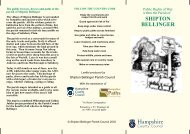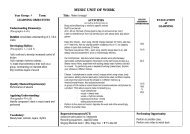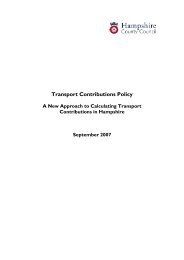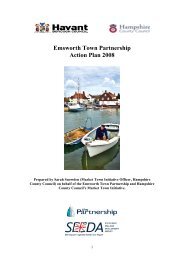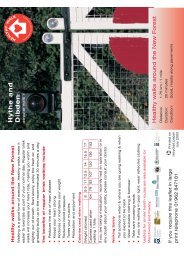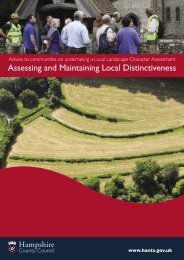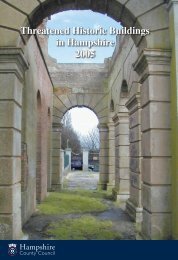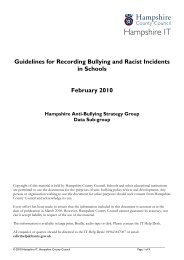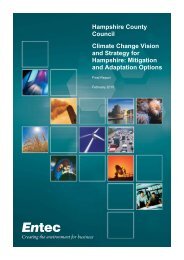GREAT CRESTED NEWT - hampshirebiodiversity.org.uk
GREAT CRESTED NEWT - hampshirebiodiversity.org.uk
GREAT CRESTED NEWT - hampshirebiodiversity.org.uk
Create successful ePaper yourself
Turn your PDF publications into a flip-book with our unique Google optimized e-Paper software.
Great Crested Newtof ponds available to them, since the suitability ofponds for newt breeding changes over time.! Pond desiccation through natural successioncan be a problem in neglected ponds, and waterabstraction can also permanently dry out ponds,making them unsuitable for newts. Theseprocesses also increase fragmentation of extantsites, reducing the chance that new areas will becolonised.! Loss or fragmentation of terrestrial habitat arealso an issue. They create barriers to dispersal andremove foraging and hibernation sites.Developments in the vicinity of breeding ponds willtherefore adversely affect the species even if thepond itself is not affected.! Inappropriate habitat management may result inhabitats becoming unsuitable. Excessive removal ofvegetation from ponds, or intensive grazing ofrough grassland, will decrease the habitat suitabilityfor newts.! Deliberate or accidental fish introductionsincrease predation on larvae.! Ponds in agricultural areas may experienceeutrophication due to fertiliser run-off.! Exotic species such as the North Americanbullfrog, Rana catesbeiana, may out-compete, orprey upon, great crested newt populations 2 .4 CURRENT ACTION4.1 National! Implementation of the UK SAP is being coordinatedby English Nature. Lead partners for theproject are Froglife, the British HerpetologicalSociety (BHS), and the HerpetologicalConservation Trust (HCT).! English Nature, Froglife and HCT fund the GreatCrested Newt Conservation Co-ordinator, whoserole is to facilitate the national SAP and give adviceon great crested newt conservation issues.! A work programme produced by the GCN SAPSteering Group has estimated the number of recolonisationsrequired to off-set current losses ofGreat crested newt populations, and has set atarget of 15 re-colonisations for Hampshire, overfive years (1998 – 2003) 3 , with none havingoccurred so far.! As yet, the species has no champion.4.2 Local! The Hampshire Amphibian and Reptile Group(HARG) have been involved in obtaining dataconcerning the distribution of the species inHampshire, by surveying ponds where the newt haspreviously been recorded, as well as new siteswhich may support the species.! Hampshire Wildlife Trust (HWT) is currentlyproducing information for Local Authorities (LAs)concerning the distribution of the species withintheir administration, and the implications of a recenttightening in the regulations concerning theprotection of schedule II species. HWT has beeninvolved with English Nature in designing mitigationmeasures in development cases where newtpopulations could potentially have been harmed.! Additionally, HWT and HARG are producing aninformation leaflet and recording form to enablemembers of the public to identify the great crestednewt and report any sightings.! HWT and other local <strong>org</strong>anisations such asHampshire County Council (HCC) are involved inmanaging reserves which contain populations ofgreat crested newt.! HARG abd HBIC are developing criteria toenable sites with great crested newts to bedesignated as Sites of Importance for NatureConservation (SINC).! The BTCV pond warden scheme, although notdirectly aimed at conserving great crested newts,may aid in creating favourable conditions for thespecies, and providing valuable data on distributionthrough communication and sharing ofinformation.2Biodiversity Action Plan for Hampshire: Volume Two January 2003
Great Crested Newt5 OBJECTIVESThe overall aim of this Plan is to protect and increase the distribution and population of the greatcrested newt in Hampshire. This broad aim translates the specific objectives set out below. Wherefeasible, objectives have been allocated targets against which achievement can be measured. The‘Proposed Action’ table in section 6 identifies the action to be taken to meet these objectives.OBJECTIVESPROPOSED ACTIONSABCDTo maintain the existing populations and range of the greatcrested newt in Hampshire, and to ensure no further loss orfragmentationTo enhance the status of the great crested newt in Hampshireby addressing the factors contributing to its decline, and byenhancing the suitability of habitats currently unoccupied by thenewts, aiding in increasing their distribution and achieving theUK target of at least 15 re-colonisations by 2015To establish and maintain a comprehensive understanding ofgreat crested newt distribution, status and ecologicalrequirements within Hampshire through appropriate research,surveying and monitoringTo promote communication, education and awareness of thestatus and needs of the great crested newt within Hampshire.1 - 11, 13 - 17, 27 - 311, 4, 9 - 19, 24, 27 - 3120 – 2926 – 313Biodiversity Action Plan for Hampshire: Volume Two January 2003
6 PROPOSED ACTIONGreat Crested NewtThe following table lists the actions required to achieve the objectives set out in this Plan. Each action has been assigned to one or more ‘Key Partners’. KeyPartners are those <strong>org</strong>anisations that are expected to take responsibility for the delivery of the actions assigned to them, according to the targets set in this Plan.Other <strong>org</strong>anisations may also be involved in the delivery of action, and they have been indicated in the ‘Others’ column.Key to symbols in Action Table:◆◆➪➨➪To be completed by the indicated year. Work can commence at any time before the due date, at the discretion of the Key Partner.Design or production of a plan/strategy to be completed by this year and then followed by its implementation.To start by the indicated year and usually followed by ongoing work. A start arrow in year 2003 can indicate a new action, or a new impetus to existing work.Work that has already begun and is ongoing.Site and Species Policy and ProtectionACTION DELIVERY BY YEAR◆ = complete by ➨ = start by➪ = ongoing ◆➪ = design by and implement1 Ensure that all ponds known to hold viable populations of great crestednewt are identified in Local plans or Part II of Unitary development plans.2 For known populations lying outside designated conservation areas,consider designation as SSSIs, SINCs, etc, in line with current criteria(Developing criteria where necessary).3 Ensure that LAs are aware of the implications of great crested newt sitesunder new legislation, (protection of Schedule II species under section 44(2) (c) of the Habitat regulations).4 Ensure that LAs have policies covering the great crested newt and otherprotected species, in relation to habitat modification, development, etc.5 Ensure that Local Planning Authorities are aware of <strong>org</strong>anisations that canassist with mitigation design in cases where development is unavoidable.6 Ensure that standard procedures are in place for assessing the suitabilityof mitigation design, both before and after implementation7 Review the effectiveness of existing pond protection measures inpreventing deterioration and loss of great crested newt habitats.8 Based on such reviews, promote the development of new measures to aidin great crested newt conservation, (Such as BTCV pond WardenKeyPartnerEN, HWT,LAsHCC, LAs,ENOthers 2003 2004 2005 2006 2010 2015HARG,HGBI.HARGHBICMEETSOBJ.◆ A, B➨ ◆ AEN, HWT LAs ➨ ◆ ALAs EN, HWT ➨ ◆ A, BHWT,HARGEN, LAs ◆ ALAs ➨ ◆ ADEFRA,EN,FWAG,PA, HWT,HCT, HWTFroglife➨ ◆ AVarious ➪ ➪ ➪ ➪ ➪ ➪ A4Biodiversity Action Plan for Hampshire Volume Two January 2003
schemes).9 Ensure that the management plans for the New Forest Special Area ofConservation (NF SAC) continues to take account of the needs of thegreat crested newt, and that the management of ponds within the NewForest is compatible with the life cycle requirements of the species, (E.g.Control of Crassula helmsii).Site and Species Management10 Encourage the favourable management of habitats that currently containgreat crested newt populations to maintain the number and distribution ofoccupied sites within Hampshire.11 Ensure the favourable management of designated sites supporting thegreat crested newt, such as SSSIs and SINCs.12 Encourage natural dispersal through suitable habitat management /restoration, considering both aquatic and terrestrial modifications, to worktowards Hampshire’s re-introduction target.13 Encourage the control / eradication of introduced species which maydetriment great crested newt populations14 Encourage bodies that offer habitat modification grants to target areas inHampshire where Great crested newt populations are known.15 Encourage the uptake of grant schemes for habitat management (E.g.Countryside Stewardship Scheme) which will aid in the protection orcreation of ponds.16 Endeavour to take account of the requirements of this species whenreviewing existing agri-environment schemes.17 Consider the expansion of such schemes, or alternative means of fundingwhere gaps exist (E.g. HWT, NGO’s).18 Utilise survey and research information to identify currently unoccupiedsites, which are / may become, suitable for supporting great crested newtpopulations, and encourage suitable management to maintain andimprove them.19 Produce further plans for re-introductions, to contribute to the target of 15re-colonisations for Hampshire, over 5 years.Research, Survey and Monitoring20 Utilise all data collected within the county to determine great crested newtdistribution. Particularly, review Hampshire pond survey information.ENEN, HWT,Landowners /managersEN, Landowners /managersEN, HWT,Landowners /managersHWT, EA,NFC,NFDCLA’s, FA,FE,DEFRA,FWAGLAs, FA,FE,DEFRA,FWAGGreat Crested Newt➪ ➪ ➪ ➪ ➪ ➪ A, B◆➪ ➪ ➪ ➪ ➪ ➪ A, B➨ ◆ A, B◆➪ ◆ BEA, EN HWT, HCC ◆➪ ➪ ➪ ➪ ➪ ➪ A, BEA, EN,HWT, LAs.DEFRA,FWAG,HWT,DEFRA,FWAG.EA, LAs,EN◆➪ ➪ ➪ ➪ ➪ ➪ A, B➪ ➪ ➪ ➪ ➪ ➪ A, BDERFA FWAG ◆➪ ➪ ➪ ➪ ➪ A, BDEFRA,FWAG.HWT, EN,HARGHWT, EN,HARG.HWT, EN,HARG.Various ◆➪ ➪ ➪ ➪ A, BLAs, Landowners /managersLAs, Landowners /managersEA, BTCV,HCC,HBIC◆➪ ➪ ➪ ➪ ➪ B◆➪ ◆ B◆ C5Biodiversity Action Plan for Hampshire Volume Two January 2003
21 Initiate surveys to confirm historic sightings, or document losses, as wascarried out for many ponds within the New Forest.HWT,HARG.Great Crested Newt➨ ◆ C6Biodiversity Action Plan for Hampshire Volume Two January 2003
Great Crested Newt22 Contribute to the production of a standard framework for surveytechniques, data recording and storage, and training of surveyors andmanagers, (i.e. Creation of county-wide / country-wide standards ).23 Encourage / carry out regular monitoring of known or suspected greatcrested newt sites, and register planned and completed surveys withFroglife, (perhaps as part of a national scheme, co-ordinated byFroglife?).24 Initiate / continue research into areas that may be suitable for greatcrested newt introduction – consider habitat suitability and impacts atsource and introduction sites.25 Suggest research subjects to be addressed and communicate these toresearch institutes, etc, (e.g. Effects of habitat modifications, etc).Communication, Awareness and Promotion26 Ensure that all relevant information (concerning both presence andabsence of the species) is made available to all relevant bodies, (E.g.BRC, LA’s)27 Facilitate the collation of all distribution and population data to oneaccessible source within the county and ensure appropriate incorporationwithin national databases, contributing to an up-to-date Red List.28 Ensure that the needs of the great crested newt are considered withinother species and habitat action plans in Hampshire, through liaison withthe Hampshire BAP and national great crested newt Steering Groups,(allowing information exchange and avoiding duplication).29 Conduct presentations / training days for all appropriate <strong>org</strong>anisations andindividuals within Hampshire highlighting the status of the great crestednewt (along with other priority species) and appropriate protection andconservation measures.30 Ensure that printed information on great crested newt conservationrequirements, sympathetic management, and available funding isavailable to all land managers and relevant bodies within Hampshire.31 Produce articles, press releases, and interpretation material concerningthe great crested newt and amphibian conservation in general, for local ornatural history press, visitor centres, and country parks.BRC, EN. Various ➨ ◆ CHWT,HARG,etc.HWT,HARG,etc.HWT,HARG, etcHWT,HARG,HBICHBIC,HWTEducationInstitutesIndividuals,Consultancies◆➪ ➪ ➪ ➪ ➪ C➪ ➪ ➪ ➪ ➪ ➪ B, C➨ ➪ ➪ ➪ ➪ C➨ ◆ C, D➪ ➪ ➪ ➪ ➪ ➪ A, B, C,D.HCC, HWT Various ◆ A, B, C,DHWT, EN ◆➪ ◆ A, B, C,DHWT, ENHWT,HARG,LAs, ENDEFRA,FRCA,Landowners /managers➨ ◆ A, B, D➪ ➪ ➪ ➪ ➪ ➪ A, B, D7Biodiversity Action Plan for Hampshire Volume Two January 2003
Great Crested NewtKEY TO ORGANISATIONS:BHS British Herpetological SocietyBRC Biological Records CentreBTCV British Trust for Conservation VolunteersDEFRA Department of the Environment, Food and Rural AffairsEA Environment AgencyEN English NatureFA Forest AuthorityFE Forestry EnterpriseFWAG Farming and Wildlife Advisory GroupHARG Hampshire Reptile and Amphibian GroupHBICHCCHCTHGBIHWTLAsNFCNFDCPAHampshire Biodiversity Information CentreHampshire County CouncilHerpetological Conservation TrustHerpetofauna Groups of Britain and Ireland NetworkHampshire Wildlife TrustLocal AuthoritiesNew Forest CommitteeNew Forest District CouncilPond Action8Biodiversity Action Plan for Hampshire Volume Two January 2003
REFERENCESGreat Crested Newt1 Biodiversity – The UK Steering Group Report: Volume2: Action Plans, Department ofthe Environment, HMSO, 1995.2 Biodiversity Action Plan for Hampshire: Volume 2, Hampshire Biodiversity partnership,2000.3 UK Great crested newt Triturus cristatus Species Action Plan Work Programme1998-2002, Great crested newt Species Action Plan Steering Group, 1998, (unpublished).4 Advice Sheet 11: Surveying for (Great crested) newt conservation, Froglife, 2001.5 Great crested newts in Hampshire, Hampshire Amphibian and Reptile Group /Hampshire Wildlife Trust, 2001 (unpublished).This is one of many Habitat, Species and Topic Action Plans being prepared by the HampshireBiodiversity Partnership. It will be monitored by the Partnership and fully reviewed.This species action plan has been prepared by Debbie Wicks and Ali Morse on behalf of theHampshire Biodiversity Partnership.For further information contact: Naomi Ewald, Hampshire Wildlife Trust, Woodside House,Woodside Road, Eastleigh, Hampshire SO50 4ET, e-mail: NaomiE@hwt.<strong>org</strong>.<strong>uk</strong> .10Biodiversity Action Plan for Hampshire: Volume Two January 2003



